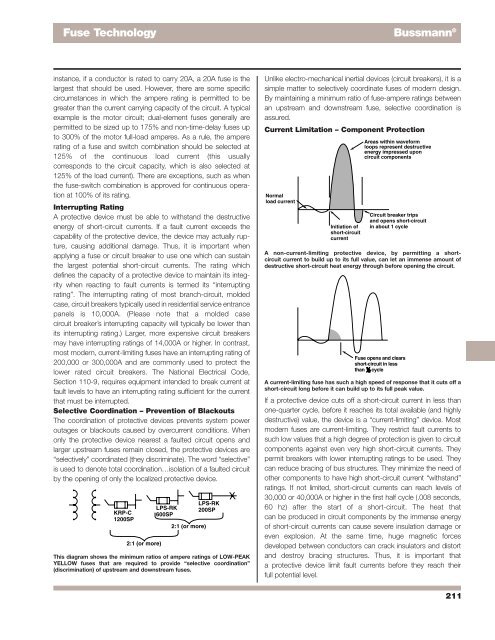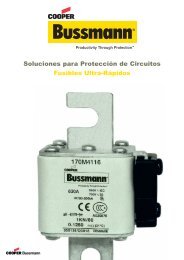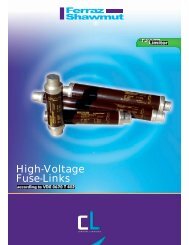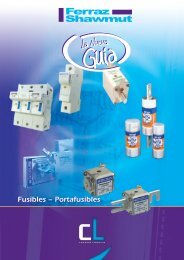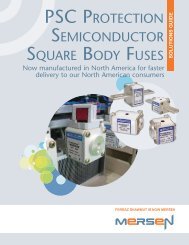Bussmann
Create successful ePaper yourself
Turn your PDF publications into a flip-book with our unique Google optimized e-Paper software.
Fuse Technology<br />
<strong>Bussmann</strong> ®<br />
instance, if a conductor is rated to carry 20A, a 20A fuse is the<br />
largest that should be used. However, there are some specific<br />
circumstances in which the ampere rating is permitted to be<br />
greater than the current carrying capacity of the circuit. A typical<br />
example is the motor circuit; dual-element fuses generally are<br />
permitted to be sized up to 175% and non-time-delay fuses up<br />
to 300% of the motor full-load amperes. As a rule, the ampere<br />
rating of a fuse and switch combination should be selected at<br />
125% of the continuous load current (this usually<br />
corresponds to the circuit capacity, which is also selected at<br />
125% of the load current). There are exceptions, such as when<br />
the fuse-switch combination is approved for continuous operation<br />
at 100% of its rating.<br />
Interrupting Rating<br />
A protective device must be able to withstand the destructive<br />
energy of short-circuit currents. If a fault current exceeds the<br />
capability of the protective device, the device may actually rupture,<br />
causing additional damage. Thus, it is important when<br />
applying a fuse or circuit breaker to use one which can sustain<br />
the largest potential short-circuit currents. The rating which<br />
defines the capacity of a protective device to maintain its integrity<br />
when reacting to fault currents is termed its “interrupting<br />
rating”. The interrupting rating of most branch-circuit, molded<br />
case, circuit breakers typically used in residential service entrance<br />
panels is 10,000A. (Please note that a molded case<br />
circuit breaker’s interrupting capacity will typically be lower than<br />
its interrupting rating.) Larger, more expensive circuit breakers<br />
may have interrupting ratings of 14,000A or higher. In contrast,<br />
most modern, current-limiting fuses have an interrupting rating of<br />
200,000 or 300,000A and are commonly used to protect the<br />
lower rated circuit breakers. The National Electrical Code,<br />
Section 110-9, requires equipment intended to break current at<br />
fault levels to have an interrupting rating sufficient for the current<br />
that must be interrupted.<br />
Selective Coordination – Prevention of Blackouts<br />
The coordination of protective devices prevents system power<br />
outages or blackouts caused by overcurrent conditions. When<br />
only the protective device nearest a faulted circuit opens and<br />
larger upstream fuses remain closed, the protective devices are<br />
“selectively” coordinated (they discriminate). The word “selective”<br />
is used to denote total coordination…isolation of a faulted circuit<br />
by the opening of only the localized protective device.<br />
KRP-C<br />
1200SP<br />
2:1 (or more)<br />
LPS-RK<br />
600SP<br />
2:1 (or more)<br />
LPS-RK<br />
200SP<br />
This diagram shows the minimum ratios of ampere ratings of LOW-PEAK<br />
YELLOW fuses that are required to provide “selective coordination”<br />
(discrimination) of upstream and downstream fuses.<br />
Unlike electro-mechanical inertial devices (circuit breakers), it is a<br />
simple matter to selectively coordinate fuses of modern design.<br />
By maintaining a minimum ratio of fuse-ampere ratings between<br />
an upstream and downstream fuse, selective coordination is<br />
assured.<br />
Current Limitation – Component Protection<br />
Normal<br />
load current<br />
Initiation of<br />
short-circuit<br />
current<br />
Areas within waveform<br />
loops represent destructive<br />
energy impressed upon<br />
circuit components<br />
Circuit breaker trips<br />
and opens short-circuit<br />
in about 1 cycle<br />
A non-current-limiting protective device, by permitting a shortcircuit<br />
current to build up to its full value, can let an immense amount of<br />
destructive short-circuit heat energy through before opening the circuit.<br />
Fuse opens and clears<br />
short-circuit in less<br />
than cycle<br />
A current-limiting fuse has such a high speed of response that it cuts off a<br />
short-circuit long before it can build up to its full peak value.<br />
If a protective device cuts off a short-circuit current in less than<br />
one-quarter cycle, before it reaches its total available (and highly<br />
destructive) value, the device is a “current-limiting” device. Most<br />
modern fuses are current-limiting. They restrict fault currents to<br />
such low values that a high degree of protection is given to circuit<br />
components against even very high short-circuit currents. They<br />
permit breakers with lower interrupting ratings to be used. They<br />
can reduce bracing of bus structures. They minimize the need of<br />
other components to have high short-circuit current “withstand”<br />
ratings. If not limited, short-circuit currents can reach levels of<br />
30,000 or 40,000A or higher in the first half cycle (.008 seconds,<br />
60 hz) after the start of a short-circuit. The heat that<br />
can be produced in circuit components by the immense energy<br />
of short-circuit currents can cause severe insulation damage or<br />
even explosion. At the same time, huge magnetic forces<br />
developed between conductors can crack insulators and distort<br />
and destroy bracing structures. Thus, it is important that<br />
a protective device limit fault currents before they reach their<br />
full potential level.<br />
211


